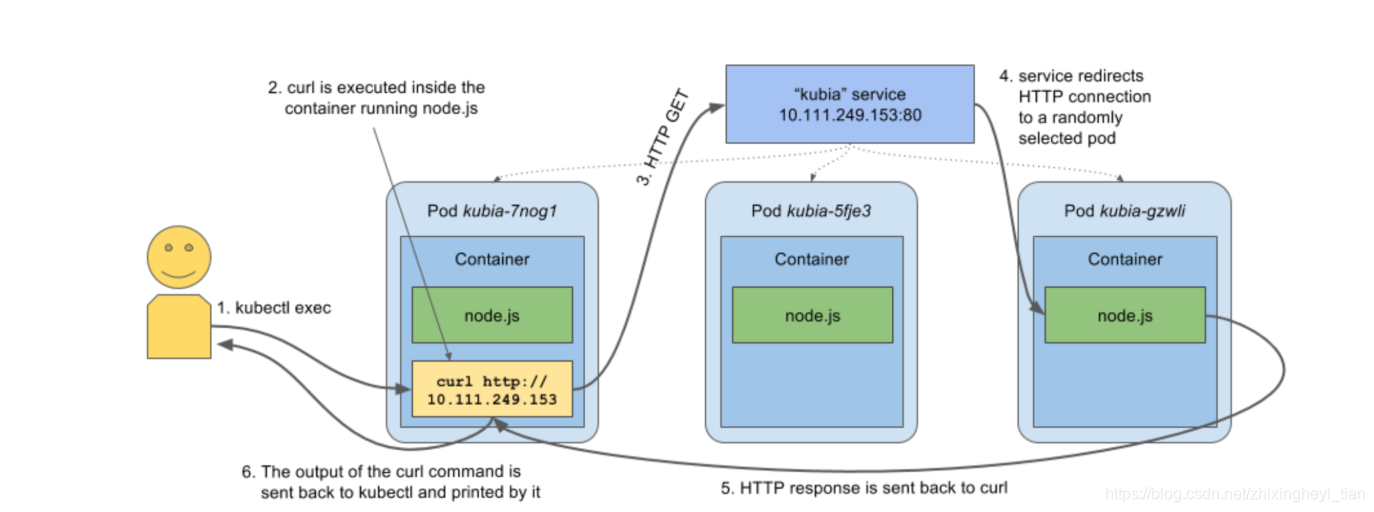进入pod
# kubectl exec kubia-p465w -it bash
root@kubia-p465w:/#
root@kubia-p465w:/#
root@kubia-p465w:/# pwd
/
root@kubia-p465w:/# ls -l
total 68
-rw-r--r-- 1 root root 354 Apr 17 07:36 app.js
drwxr-xr-x 1 root root 4096 Jul 24 2017 bin
drwxr-xr-x 2 root root 4096 Jul 13 2017 boot
drwxr-xr-x 5 root root 360 Apr 18 07:05 dev
drwxr-xr-x 1 root root 4096 Apr 18 07:04 etc
drwxr-xr-x 1 root root 4096 Jul 26 2017 home
drwxr-xr-x 1 root root 4096 Jul 24 2017 lib
drwxr-xr-x 2 root root 4096 Jul 23 2017 lib64
drwxr-xr-x 2 root root 4096 Jul 23 2017 media
drwxr-xr-x 2 root root 4096 Jul 23 2017 mnt
drwxr-xr-x 1 root root 4096 Aug 18 2017 opt
dr-xr-xr-x 265 root root 0 Apr 18 07:05 proc
drwx------ 1 root root 4096 Aug 18 2017 root
drwxr-xr-x 1 root root 4096 Apr 18 07:05 run
drwxr-xr-x 2 root root 4096 Jul 23 2017 sbin
drwxr-xr-x 2 root root 4096 Jul 23 2017 srv
dr-xr-xr-x 12 root root 0 Apr 18 07:04 sys
drwxrwxrwt 1 root root 4096 Jul 24 2017 tmp
drwxr-xr-x 1 root root 4096 Aug 18 2017 usr
drwxr-xr-x 1 root root 4096 Jul 26 2017 var
显示标签
# kubectl get pods --show-labels
NAME READY STATUS RESTARTS AGE LABELS
kubia-p465w 1/1 Running 0 25h run=kubia
kubia-tqrvp 1/1 Running 0 25h run=kubia
kubia-wzmcz 1/1 Running 0 27h run=kubia
创建服务
yaml 配置文件
# cat kubia-svc.yaml
apiVersion: v1
kind: Service
metadata:
name: kubia
spec:
ports:
- port: 80
targetPort: 8080
selector:
run: kubia
创建
# kubectl create -f kubia-svc.yaml
service/kubia created
显示
# kubectl get svc
NAME TYPE CLUSTER-IP EXTERNAL-IP PORT(S) AGE
kubernetes ClusterIP 10.96.0.1 <none> 443/TCP 10d
kubia ClusterIP 10.104.122.250 <none> 80/TCP 4s
kubia-http LoadBalancer 10.98.198.100 <pending> 8080:32099/TCP 27h
TESTING A SERVICE FROM WITHIN THE CLUSTER
So, how can we test our service from within the cluster? We want to perform an HTTP request against our service and see the response. There are a few ways we can do that. Here’s a few:
- The obvious way is to create a pod that will perform the request and log the response. We can then examine the pod’s log to see what the service’s response was.
- We can ssh into one of the Kubernetes nodes and use the curl command(这一条方法似乎不可行), or
- We can execute the curl command inside one of our existing pods through the kubectl exec command.
EXECUTING COMMANDS IN RUNNING CONTAINERS
# kubectl exec kubia-wzmcz -- curl -s 10.104.122.250:80
You've hit kubia-tqrvp
# kubectl exec kubia-wzmcz -- curl -s 10.104.122.250:80
You've hit kubia-p465w
或者先登陆一台pod
# kubectl exec kubia-p465w -it bash
root@kubia-p465w:/#
root@kubia-p465w:/opt/yarn/bin# curl 10.104.122.250:80
You've hit kubia-wzmcz
root@kubia-p465w:/opt/yarn/bin# curl 10.104.122.250:80
You've hit kubia-tqrvp
root@kubia-p465w:/opt/yarn/bin# curl 10.104.122.250:80
You've hit kubia-tqrvp
root@kubia-p465w:/opt/yarn/bin# curl 10.104.122.250:80
Figure : Using kubectl exec to run curl in one of the pods and test out a connection to the service

CONFIGURING SESSION AFFINITY ON THE SERVICE
If we execute the same command a few more times, we should hit a different pod with every invocation(调用), because the service proxy normally forwards each connection to a randomly selected backing pod, even if the connections are being opened by the same client.
If, on the other hand(另一方面), we want all requests made by a certain client to be redirected(重定向) to the same pod every time, we can set the service’s sessionAffinity property to ClientIP
(instead of None, which is the default)
apiVersion: v1
kind: Service
spec:
sessionAffinity: ClientIP
...
Environment variables in a container
kubectl exec kubia-p465w env
PATH=/usr/local/sbin:/usr/local/bin:/usr/sbin:/usr/bin:/sbin:/bin
HOSTNAME=kubia-p465w
SPARK_PI_UI_SVC_PORT_4040_TCP_ADDR=10.109.107.84
KUBIA_HTTP_SERVICE_HOST=10.98.198.100
KUBIA_HTTP_SERVICE_PORT=8080
KUBERNETES_SERVICE_HOST=10.96.0.1
KUBERNETES_PORT_443_TCP=tcp://10.96.0.1:443
KUBERNETES_PORT_443_TCP_PORT=443
KUBERNETES_PORT_443_TCP_ADDR=10.96.0.1
SPARK_PI_UI_SVC_SERVICE_PORT=4040
KUBIA_HTTP_PORT=tcp://10.98.198.100:8080
SPARK_PI_UI_SVC_SERVICE_HOST=10.109.107.84
SPARK_PI_UI_SVC_SERVICE_PORT_SPARK_DRIVER_UI_PORT=4040
SPARK_PI_UI_SVC_PORT=tcp://10.109.107.84:4040
KUBIA_HTTP_PORT_8080_TCP_ADDR=10.98.198.100
KUBERNETES_SERVICE_PORT=443
SPARK_PI_UI_SVC_PORT_4040_TCP=tcp://10.109.107.84:4040
SPARK_PI_UI_SVC_PORT_4040_TCP_PORT=4040
KUBIA_HTTP_PORT_8080_TCP=tcp://10.98.198.100:8080
KUBIA_HTTP_PORT_8080_TCP_PROTO=tcp
KUBIA_HTTP_PORT_8080_TCP_PORT=8080
KUBERNETES_SERVICE_PORT_HTTPS=443
KUBERNETES_PORT=tcp://10.96.0.1:443
KUBERNETES_PORT_443_TCP_PROTO=tcp
SPARK_PI_UI_SVC_PORT_4040_TCP_PROTO=tcp
NPM_CONFIG_LOGLEVEL=info
NODE_VERSION=7.10.1
YARN_VERSION=0.24.4
HOME=/root
FQDN
fully-qualified domain name (FQDN)
CONNECTING TO THE SERVICE THROUGH ITS FQDN
default stands for the namespace the service is defined in and svc.cluster.local is a configurable cluster domain suffix.
root@kubia-3inly:/# curl http://kubia.default.svc.cluster.local
You’ve hit kubia-5asi2
root@kubia-3inly:/# curl http://kubia.default
You’ve hit kubia-3inly
root@kubia-3inly:/# curl http://kubia
You’ve hit kubia-8awf3
we can hit our service simply by using the service’s name as the hostname in the
requested URL. We can omit(省略) the namespace and the svc.cluster.local suffix because of how the DNS resolver inside each pod’s container is configured. Look at the /etc/resolv.conf file in the container and you’ll understand:
root@kubia-p465w:/# cat /etc/resolv.conf
nameserver 10.96.0.10
search default.svc.cluster.local svc.cluster.local cluster.local
options ndots:5
curl-ing the service works, but ping-ing it doesn’t. This is because the service’s cluster IP is just a virtual IP, and only has meaning when combined with the service port.
service endpoints
# kubectl get endpoints kubia
NAME ENDPOINTS AGE
kubia 172.17.0.10:8080,172.17.0.7:8080,172.17.0.9:8080 27h
kubectl get pods -o wide
NAME READY STATUS RESTARTS AGE IP NODE NOMINATED NODE READINESS GATES
kubia-p465w 1/1 Running 0 2d5h 172.17.0.10 minikube <none> <none>
kubia-tqrvp 1/1 Running 0 2d5h 172.17.0.9 minikube <none> <none>
kubia-wzmcz 1/1 Running 0 2d7h 172.17.0.7 minikube <none> <none>
Keep the pod starting
kubectl run dnsutils --image=tutum/dnsutils --generator=run-pod/v1 \
--command -- sleep infinity






 本文探讨了在Kubernetes环境中如何通过Pod访问集群内的服务,包括使用kubectl exec命令执行curl测试,配置服务会话亲和性,以及通过FQDN连接服务。展示了环境变量在容器中的作用,并解释了如何通过服务端点查看后端Pod。
本文探讨了在Kubernetes环境中如何通过Pod访问集群内的服务,包括使用kubectl exec命令执行curl测试,配置服务会话亲和性,以及通过FQDN连接服务。展示了环境变量在容器中的作用,并解释了如何通过服务端点查看后端Pod。

















 1万+
1万+

 被折叠的 条评论
为什么被折叠?
被折叠的 条评论
为什么被折叠?










